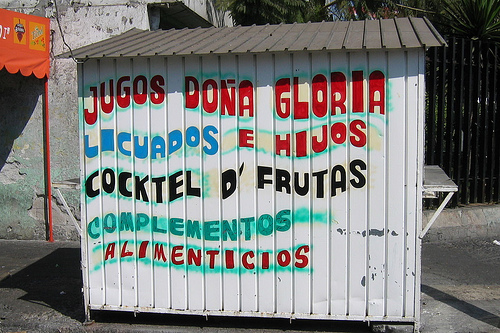The diversity of Spanish
 |
| All Spanish dialects are mutually intelligible Photo credit: * CliNKer * licensed CC BY-SA 2.0 |
It is said a language changes color, though hardly noticeable, every 50 miles. So, in effect, every village, every town, every community has its own dialect unique to its speech. However, not only are such variances out of this article’s scope, they are best absorbed once you have perfected basic communication skills and start interacting with the locals more regularly. This article is more about how Spanish is divided by the vast expanses of the Atlantic.
Same Spanish, different meanings
What follows is a list of some words unique to Latin-American Spanish along with their Castilian (mainland) and English equivalents. The first word in each row is Latin-American Spanish, the second, Castilian Spanish, and the third is English.
abreviarse – apresurarse –to hurry
acogencia – acogida/aceptación – welcome/acceptance
acuerpar – defender – to defend
afanar – ganar dinero – to earn money
amargoso – amargo – bitter
arrancarse – despedirse – to take time off
balaceo – tiroteo – gunfight
bestia – caballo – horse
bolilos – panecillos – buns, small loaves
bregar – trabajar – to work
camión – autobús – bus
candela – fuego – fire, cigarette light
catar – mirar – to look at
chancleta – acelerador – accelerator
closet – armario – closet/cupboard
computadora – ordenador – computer
diarismo – periodismo – journalism
de juro – sin remedio/a la fuerza – truly/by force
de pie – constantemente – constantly
despacharse – darse prisa – to hurry
droga – deuda – debt
eleccionario – electivo/elector – voter
esportivo – deportivo – sporting
estación – pinchazo – puncture
estampilla – sello – stamp
exigir – rogar – to ask
expeditar – despachar – to expedite or hurry along
expendio – local de venta al por menor – retailer
fatiga – agonía – agony
festinar – festejar – to celebrate
foja – hoja de papel – sheet of paper
frazada/cobija – manta – blanket
lindo – bonito – pretty
luego – al instante – right away
manejar – conducir – to drive
marfil – peine – comb
masacrar/ultimar – matar – to kill
memorias – recuerdos/saludos – memories
mercar – comprar – to buy
palo – trago – a drink
pararse – ponerse en pie – to stand up
parquear – aparcar – to park
plata – dinero – money
¿Qué tanto? – ¿Cuánto? – How much/many?
quedado/quedadizo – lento/indolente – slow/indolent
rajar – gastar mucho dinero – to spend a lot of money
rango – lujo – luxury
recordarse – despertarse – to wake up
rentar – alquilar – to rent
ruletero – taxista – cab driver
sabana – llanura – plain/savanna
saber – soler – to be used to
saco – chaqueta – jacket
sentirse – resentirse/estar dolido – to be upset
taita – padre – father
tajarrazo – herida – injury
tinto – café negro – black coffee
ubicar – colocar en un sitio precioso – to put in a particular spot/place
vallunco – rústico/burdo – vulgar/rustic
venduta – venta pública – sale to the public
zipote – muchacho – young man
Of course, this is not all there is!
I am sure you understand that no list can fully capture the diversity of a language as rich as Spanish. Close to a dozen countries speak this lingo and the speakers represent a cultural diversity as broad as few other languages. From indigenous Indians of Perú to the Caucasians of Spain and from the Negros of the Caribbean to the Mestizos of Mexico, the speakers of this language obviously show a variety no word-list can reasonably encapsulate.
As always, I would strongly urge those who are learning Spanish and wish to further research these lexical variances to step out of their comfort-zones, make friends with those native speakers and explore this diversity for themselves. While the list above should do well to give you a hint of how Spanish of the New World sounds different from that of Spain, the actual count of such differences is practically limited only by the innate human kack for cultural variety. As a further illustration, there’s an interesting article on the Spanish language translation for “bathing.”
As a closing note, I must also let you know that when a language changes its color along with geography, it is not only in its vocabulary. Spanish exhibits many examples of changes even in its grammar when it comes to local usage and while most local grammatical constructs are non-standard, a knowledge of their patters surely enriches your experience and brings you steps closer to your culture of choice. Pronunciation too undergoes similar changes and makes for an interesting study.












.png)